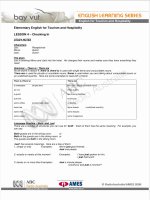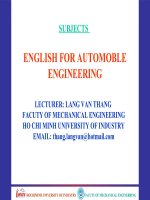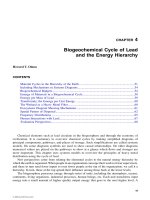Technical english for automotive engineering chapter 4 suspension
Bạn đang xem bản rút gọn của tài liệu. Xem và tải ngay bản đầy đủ của tài liệu tại đây (920.18 KB, 7 trang )
SUSPENSION SYSTEM
4
Chapter 4: Suspension System.
I. PRE-READING QUESTION
1. How to maximize the friction between the tires of a car and the road surface?
2. How to provide steering stability with good handling and to ensure the comfort of the
passengers?
3. How to absorb the vibration in moving of the cars?
II. READING
Another major automotive sub-system is the suspension system, which is the mechanical
assembly that connects each wheel to the car body. The primary purpose of the suspension
system is to isolate the car body from the vertical motion of the wheels as they travel over the rough
road surface. The suspension system can be understood with reference to Figure 4.1, which illustrates
the major components.
Fig 4.1: Major components of suspension system.
1. SPRINGS
Notice that the wheel assembly is connected through a movable assembly to the body. The weight
of the car is supported by SPRINGS. Today's springing systems are based on one of four basic
designs:
1.1. Coil springs: this is the most common type of spring and is, in essence, a heavy-duty torsion
bar coiled around an axis. Coil springs compress and expand to absorb the motion of the wheels (Fig
4.1).
1.2. Leaf springs: this
type of spring consists of
several layers of metal
(called "leaves") bound
together to act as a single
unit. Leaf springs were
first used on horse-drawn
carriages and were found
on
most
American
automobiles until 1985.
They are still used today
on most trucks and heavyduty vehicles (Fig 4.2)
Fig 4.2: Leaf spring.
Technical English for AUTOMOTIVE ENGINEERING.
21
SUSPENSION SYSTEM
4
Fig 4.3: Leaf spring assembly
1.3 Torsion bars: torsion bars
use the twisting properties of a steel
bar to provide coil-spring-like
performance. The short torsion bar
springs grip into the guide tubes 2 and
3 in the centre of the vehicle (Fig 4.4).
Parts 2, 3 and 4 are jointly subjected
to torsional stresses and so the
torsional stiffness of the transverse
tubes contributes to the spring rate. On
the outside, the cast trailing arms 1
are welded to the transverse tubes,
which (pushed into each other) support
each other on the torsionally elastic
bearings 5 and 6. This creates a
sufficiently long bearing basis, which
largely prevents camber and toe-in
changes when forces are generated.
Fig 4.4: Torsion bars in suspension system
The entire assembly is fixed by the
brackets 7 which permits better force
transfer on the body side sill. Guide tubes 2 and 3 are mounted in the brackets and can rotate, as well
as the outer sides of the two torsion bars 4. The two arms thus transfer all vertical forces plus the
entire springing moment to the body. The anti-roll bar 8 is connected to the two trailing arms via two
U-shaped tabs. The two rubber bearings 5 and 6 located between the tubes 2 and 3 also contribute
to the stabilizing effect. The bump and rebound travel stops are fitted into the shock absorber 9.
1.4 Air springs: The air-spring bellows
are supplied by an electrically powered
compressor.
The
individual
wheel
adjustment permits the lowering or lifting of
the vehicle as well as a constant vehicle
height, regardless of – even onesided –
loading. It is also possible to counteract
body tilt during cornering. The damping
properties of the shock absorbers are
affected by spring bellow pressure
depending on the load (Fig 4.5)
Fig 4.5: Air springs in suspension system
Technical English for AUTOMOTIVE ENGINEERING.
22
SUSPENSION SYSTEM
4
2. SHOCK ABSORBER (sometimes a strut)
(Fig 4.6), which is in effect a viscous damping
device. There is a similar assembly at each wheel,
although normally there are differences in the
detailed configuration between front and rear
wheels.
Enter the shock absorber, or snubber, a
device that controls unwanted spring motion
through a process known as dampening. Shock
absorbers slow down and reduce the magnitude
of vibratory motions by turning the kinetic
energy of suspension movement into heat
energy that can be dissipated through hydraulic
fluid.
A shock absorber is basically an oil pump
placed between the frame of the car and the
wheels. The upper mount of the shock connects
Fig 4.6: Shock Absorber.
to the frame (i.e., the sprung weight), while the
lower mount connects to the axle, near the wheel (i.e., the unsprung weight). In a twin-tube
design, one of the most common types of shock absorbers, the upper mount is connected to a
piston rod, which in turn is connected to a piston, which in turn sits in a tube filled with
hydraulic fluid. The inner tube is known as the pressure tube, and the outer tube is known as
the reserve tube. The reserve tube stores excess hydraulic fluid.
When the car wheel encounters a bump in the road and causes the spring to coil and
uncoil, the energy of the spring is transferred to the shock absorber through the upper mount,
down through the piston rod and into the piston. Orifices perforate the piston and allow fluid
to leak through as the piston moves up and down in the pressure tube. Because the orifices are
relatively tiny, only a small amount of fluid, under great pressure, passes through. This slows
down the piston, which in turn slows down the spring.
Shock absorbers work in two cycles -- the compression cycle and the extension cycle.
The compression cycle occurs as the piston moves downward, compressing the hydraulic
fluid in the chamber below the piston. The extension cycle occurs as the piston moves toward
the top of the pressure tube, compressing the fluid in the chamber above the piston. A typical
car or light truck will have more resistance during its extension cycle than its compression
cycle. With that in mind, the compression cycle controls the motion of the vehicle's unsprung
weight, while extension controls the heavier, sprung weight.
SUSPENSION TYPES
3.1 Dependent Suspensions
3.1.1 Dependent front suspensions: have a
rigid front axle that connects the front
wheels. Basically, this looks like a solid bar
under the front of the car, kept in place by leaf
springs and shock absorbers. Common on
trucks, dependent front suspensions haven't
been used in mainstream cars for years.
Fig 4.7: Dependent front
suspensions
Technical English for AUTOMOTIVE ENGINEERING.
23
SUSPENSION SYSTEM
4
3.1.2 Dependent rear suspensions
Fig 4.8: Solid-axle, leaf-spring
Fig 4.9: Solid-axle, coil-spring
Contrary to the front version of
this system, many cars are still
designed
and
built
with
dependant
(linked)
rear
suspension systems.
Fig 4.10: Beam Axle
3.2 Independent Suspensions
3.2.1 Independent front Suspensions
Fig 4.12: Coil Spring type 1
Fig 4.11: Macpherson strut
So-named because the front wheel's
suspension systems are independant of
each other (except where joined by an
anti-roll bar). These came into existance
around 1930 and have been in use in one
Fig 4.13: Coil Spring type 2
Technical English for AUTOMOTIVE ENGINEERING.
24
SUSPENSION SYSTEM
4
form or another pretty much ever since then.
Fig 4.14: Double Wishbone
3.2.2 Independent rear Suspensions
Fig 4.15: Multi-link suspension
Fig 4.16: The rear axle on Mitsubishi Pajero
III. NEW WORDS
isolate
spring
in essence
leaf spring
twist
stiffness
counteract
magnitude
sprung weight
hydraulic fluid
orifice
mainstream
existance
rough
car frame
heavy-duty
bound
grip
transverse tube
tilt
vibratory
axle
reserve tube
perforate
contrary
wishbone
suspension system
lower control arm
torsion
horse-drawn carriages
guide tubes
trailing arms
strut
kinetic energy
unsprung weight
excess
dependent suspensions
independent suspensions
multi-link suspension
Technical English for AUTOMOTIVE ENGINEERING.
shock absorber
coil spring
absorb
torsion bars
torsional stress
air springs
snubber
dissipate
twin-tube
encounters
rigid front axle
so-named
antiroll bar
25
SUSPENSION SYSTEM
4
IV. COMPREHENSION QUESTION
1. What system connects each wheel to the car body?
----------------------------------------------------------------------------------------------------------------2. What is/are the primary purpose(s) of the suspension system?
----------------------------------------------------------------------------------------------------------------3. How to support the weight of the car?
----------------------------------------------------------------------------------------------------------------4. What are the four basic designs of the springing systems?
----------------------------------------------------------------------------------------------------------------5. How do coil springs absorb the motion of the wheels?
----------------------------------------------------------------------------------------------------------------6. How to constitute the leaf springs?
----------------------------------------------------------------------------------------------------------------7. What is/are the property(ies) of the Torsion bars for supplying coil-spring-like
performance?
----------------------------------------------------------------------------------------------------------------8. Are the air springs possible to counteract body tilt during cornering?
----------------------------------------------------------------------------------------------------------------9. Is it the same kind of shock absorber assembly at each wheel in a car?
----------------------------------------------------------------------------------------------------------------10. How do the shock absorbers slow down and reduce the magnitude of vibratory motions?
----------------------------------------------------------------------------------------------------------------V. TRUE/FALSE
1. Suspension system connects each wheel to the car body. ( True False)
2. The primary purpose of the suspension system is to isolate the car body from the
horizontal motion of the wheels as they travel over the rough road surface. ( True
False)
3. The springs in suspension system support the weight of the car. ( True False)
4. Coil springs compress and expand to absorb the motion of the wheels. ( True False)
5. Leaf springs consist of several layers of metal bound together to act as a single unit. (
True False)
Technical English for AUTOMOTIVE ENGINEERING.
26
SUSPENSION SYSTEM
4
6. Leaf springs were first used on bicycle. ( True False)
7. Leaf springs are used today on all trucks and heavy-duty vehicles. ( True False)
8. Torsion bars use the compressing properties of a steel bar to provide coil-spring-like
performance. ( True False)
9. The air-spring suspension system are supplied by an electrically powered compressor. (
True False)
10. Shock absorbers effect as a viscous damping device. ( True False)
11. Shock absorbers control wanted spring motion through a process known as dampening. (
True False)
12. Shock absorbers slow down and reduce the magnitude of vibratory motions by turning the
kinetic energy of suspension movement into chemical energy. ( True False)
13. A shock absorber is basically an oil source placed between the frame of the car and the
wheels. ( True False)
14. The sprung weight is the upper mount of the shock connects to the frame. ( True
False)
15. The unsprung weight is the lower mount connects to the axle, near the wheel. ( True
False)
16. Shock absorbers work in the compression cycle and the extension cycle. ( True False)
17. Dependent Suspensions have a rigid axle that connects the front wheels. ( True False)
18. Independent suspensions is named because the wheel's suspension systems are
independant of each other. ( True False)
19. Engine, clutch, transmission, drive shaft, differential and driven wheels are elements of
drivetrain system. ( True False).
VI. WORD(S) SELECTIONS.
Select ONE word(s) in the below box and fill in the gap in column B with its meaning word in
column A
a. One type of
spring
is
supplied by an
electrically
powered
compressor
b. A device
controls
wanted spring
motion through
a
process
known
as
dampening.
No
1
2
3
4
5
c. One type of
spring consists of
several layers of
metal
bound
together to act as
a single unit
e. The upper
mount of the
g. link
shock connects
to the frame.
i. The lower
mount
connects
to
the axle, near
the wheel
h. One type of
f.
System spring uses twisting
j. frustrate
d.
High connects each properties of a steel
performance
wheel to the car bar to provide coilbody
spring-like
performance
Column A
Suspension system
Leaf spring
Torsion bars
The unsprung weight
heavy-duty
Column B
No
6
7
8
9
10
Technical English for AUTOMOTIVE ENGINEERING.
Column A
air-spring suspension
Shock absorbers
The sprung weight
counteract
bound
Column B
27









